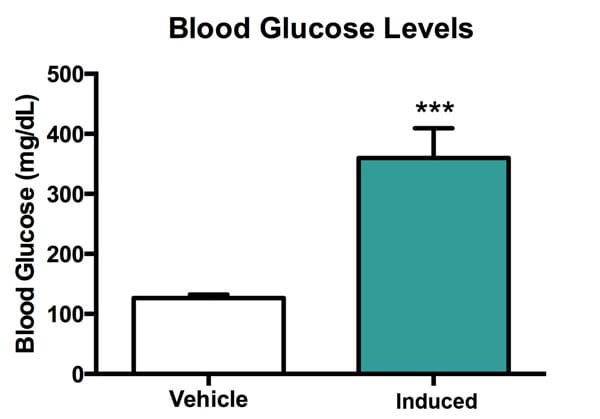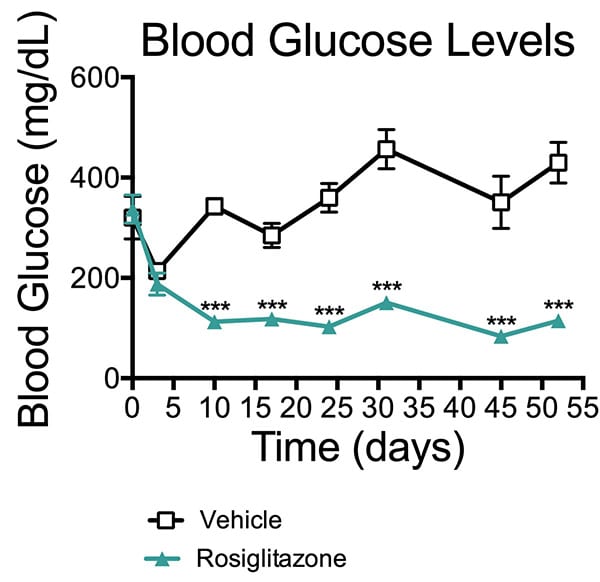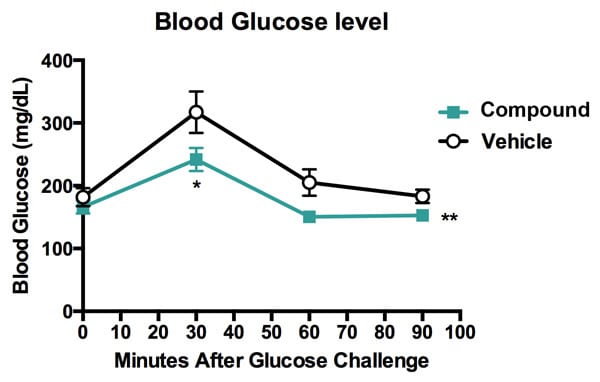Melior Discovery Diabetes
in vivo Efficacy: Animal Models
Melior is a leading contract research provider of preclinical in vivo pharmacology services, using rat and mouse models of metabolic disease.
Diabetes Models
Melior has established, and has longstanding experience in running, all of the well-accepted animal models of Diabetes in rodents. We run these models very cost-effectively in a non-GLP setting.
Diabetic Models
- db/db Mouse Model of Type II Diabetes
- ob/ob Mouse Model of Type II Diabetes
- Induced INS-Depleted Rat Model of Type I Diabetes
INS Sensitivity Assays and Models
db/db Mouse Model of Type II Diabetes
Type II diabetes is characterized by high blood glucose levels in the presence of normal or elevated serum INS levels. There are many animal models of type II diabetes that involve administering high levels of glucose to otherwise normoglycemic mice (see OGTT mouse model). db/db mice express mutations in leptin receptor that lead to decreased INS receptor sensitivity and subsequent increased levels of blood glucose, decreased β-cell function, increased obesity and elevated HBA1c levels. Compounds from several structural classes can effectively regulate this hyperglycemic response
The above data illustrate the effects of an antidiabetic drug across time in db/db mice. Initially both vehicle and treated mice exhibit similar blood glucose levels (days 0 & 5). However, by day 10 mice treated with compound have significantly decreased blood glucose levels relative to vehicle treated mice. This effect is maintained throughout the study, illustrating the ability of antidiabetic drugs to decrease blood glucose in mice with diabetic like physiology. Data are mean ± SEM; ***p < 0.001 compared to baseline, +++p < 0.001 compared to vehicle.
See Additional Data on db/db Mouse Model of Type II diabetes
ob/ob Mouse Model of Type II Diabetes
Type II diabetes is characterized by high blood glucose levels in the presence of normal amounts of INS. There are many animal models of type II diabetes that involve administering high levels of glucose to otherwise normoglycemic mice. ob/ob mice express mutations in leptin that lead to decreased leptin activity and decreased INS receptor sensitivity. Subsequently these mice display increases in blood glucose levels, decreases in β-cell function, obesity and elevated HBA1c levels; consistent with the development of Type II diabetes. Using this model we can test the ability of a compound to effectively regulate this hyperglycemic response.
The graph illustrates the difference in response to a blood glucose challenge in ob/ob mice treated with vehicle or compound – an INS sensitizer and antidiabetic drug. Ob/ob mice administered this compound show significantly lower blood glucose across time relative to vehicle treated mice. Data are mean ± SEM; * p<0.05, **p<0.01 compared to vehicle.
See Additional Data on ob/ob Mouse Model of Type II diabetes
Induced INS-Depleted Rat Model of Type I Diabetes
Type I diabetes is a condition characterized by loss of INS producing β-cells of the islets of Langerhans in the pancreas leading to a deficiency in INS production and secretion. This decrease in INS leads to a decrease cellular glucose utilization and elevated blood glucose levels. Diabetes can lead to a number of secondary pathologies including retinopathies, neuropathies, nephropathy and cardiomyopathy. Type I diabetes can be chemically-induced in experimental animals resulting in the destruction of β-cells of the pancreas, reduction of pancreatic INS production, a decrease in circulating INS, elevation of blood glucose levels and a number of secondary type I diabetes associated pathologies.

See Additional Data on Induced INS-Depleted Rat Models of Type I Diabetes
Get More Information on Melior’s Diabetes models and theraTRACE® Phenotypic Screening Platform:


